With careful management under the Toronto and Region Conservation Authority, several previously fragile species are returning to the GTA.
At the very foot of Spadina Avenue, the city’s first wavedeck undulates gently against Toronto’s Inner Harbour. Its ipe wood and yellow cedar planks are an homage to the lakeshore’s former natural contours, and people sitting on the deck’s edge can peer over into Lake Ontario. If the water is calm and clear, they will likely see pike darting to and fro in the water. Lucky fishermen might even be able to catch one and bring it home for supper.
But the wavedeck has a surprising secret hidden below its curves. It sits atop a fish habitat installed by the Toronto Region Conservation Authority. “These were called fish condos,” says Gord MacPherson, the associate director of restoration projects at the Toronto and Region Conservation Authority’s Restoration and Infrastructure Division. “The construction guys were like, ‘Are you kidding me?’ They thought there was no way it was going to work. We took tree trunks and embedded them in a block of concrete, and stuck them down there. Fish love that. When they put them in, the water was crystal clear, and the fish started moving in.”
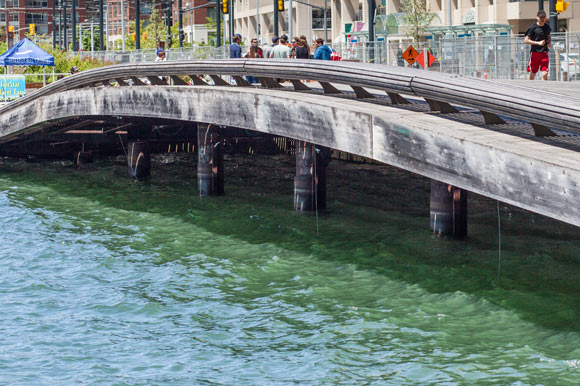 A fish habitat exists under the Wavedeck.
A fish habitat exists under the Wavedeck.
The pike didn’t come back overnight. “This was industrial land,” says MacPherson. “They used to make artillery shells on this site during the First World War. The harbour had a smell to it when I was a kid.”
In the 1970s, the emerging environmental movement led to a ban on phosphorus in laundry detergents; phosphorus runoff into the Great Lakes was causing massive algae blooms and blighting native aquatic plants. After phosphorus was banned, Lake Ontario slowly returned to health. Even in the 1980s, MacPherson recalls, the dominant fish species were carp and suckerfish. But with the return of the aquatic plants, and the installation of fish habitats along the waterfront, the pike (not to mention the walleye and bass) have grown in numbers. MacPherson says that a recent hydroacoustic survey of the harbour collected more than three million pings from pike; in past years, he says, the number was closer to three
hundred.
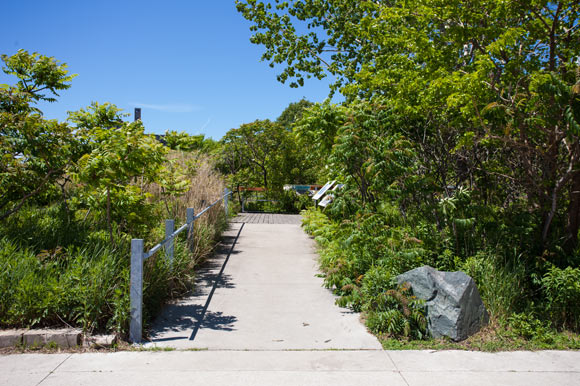 Spadina Quay Wetland.
Spadina Quay Wetland.The harbour isn’t the only place where formerly threatened species are thriving. Just to the west of the wavedeck is the Spadina Quay Wetland, a 2800-square meter wild zone that was a parking lot before the TCRA transformed it in 1999. The property was purchased at the cost of eight million dollars. Local high school students came for a few years to tend to the wetland; now, MacPherson says, the only attention it needs is the occasional garbage pick-up. The wetland is home to red-winged blackbirds, native grasses, and the occasional beaver or snapping turtle. In high-water years, it also provides a spawning ground for pike.
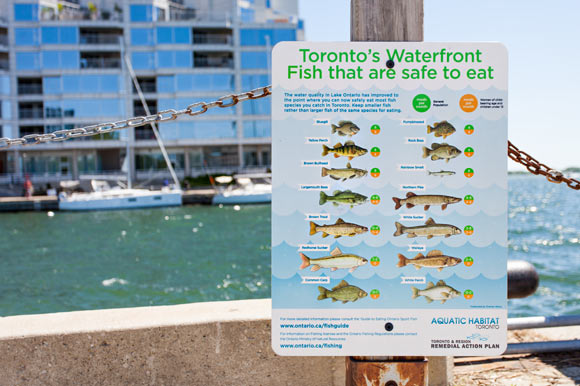 Signs explaining the types of fish living in Toronto's waterfront.
Signs explaining the types of fish living in Toronto's waterfront.The TCRA has turned its attention to plenty of other areas in the GTA. Last year, MacPherson says, they took on 175 restoration projects. One of the biggest projects under their purview is the ongoing naturalization of Tommy Thompson Park, at the bottom of Leslie Street. “We have our complete financial allotment to do it, but it’s a very technically challenging project. It’s building a wetland on top of sediments that we have to cap.” The result will be an expanded habitat for the more than 300 bird species that can be found there, including the double-crested cormorant. “When I first started at the authority thirty years ago, I spent the whole summer out on Lake Ontario, every single day. I saw three of those birds,” says MacPherson. “Their eggs were thin because of DDT, and now that DDT levels have dropped, their numbers have spiked. We now manage one of the largest colonies in the lower Great Lakes at Tommy Thompson Park.”
Striking a balance between a returning species and their habitats isn’t always easy. The double-crested cormorant is an excellent example of a success story with an asterisk. “They destroy the trees they nest in,” explains Amanda Buckiewicz, series producer on
Great Lakes Wild. “Their feces—or guano—is really acidic. Also, even though they’re great at flying, they’re bad at landing, so they like to clear a path to their nest.” The result is a serious impact on the tree canopy. “Toronto is one of the few cities in the world that refuses to control them lethally. After all, they were here first! Instead, the TRCA has created ground nesting habitats for the birds to keep them out of the trees.” The initiative has reduced the number of tree-nesting birds from 85% to under 50%. “They’ll never get it down to zero, and they don’t want to, because by killing trees, the cormorants are actually creating habitat for ground nesting birds. It’s all a cycle of nature!” says Buckiewicz.
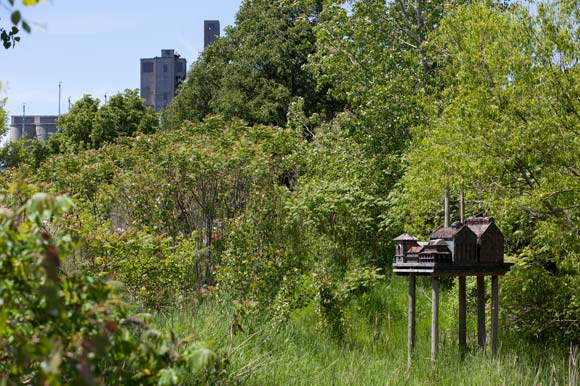 Animal habitats in the Spadina Quay Wetland.
Animal habitats in the Spadina Quay Wetland.Creating habitats for native species has an impact on Toronto’s human population as well. Take, for example, the floodplains of the Lower Don River, a 1600-acre area high on MacPherson’s wish list. “The whole reason we’re [looking at] the mouth of the Don isn’t for habitats. It’s to alleviate floods. If we ever had another Hurricane Hazel, half of the Lower Don River would flood out. If we put in a natural habitat and realign the Don, you can take care of the flood risk, and you’ve got a whole patch of wetland.” While there’s no set date for work to begin on the area, MacPherson is still excited by its potential. “It’s going to be a great spot for people to live in, and it’s going to be a great parkland.”
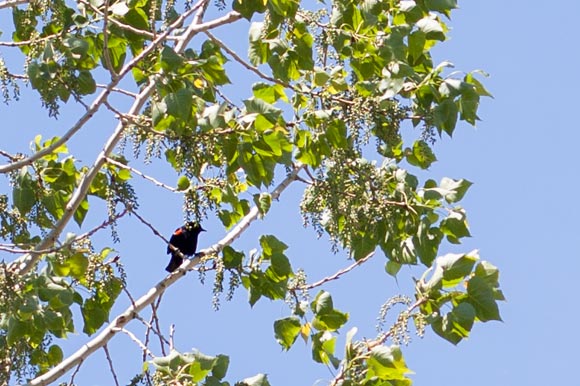 Red-winged blackbird in the Spadina Quay Wetland.
Red-winged blackbird in the Spadina Quay Wetland.
As we chat in the Spadina Quay Wetland, a flock of double-crested cormorant flies by. A red-wing blackbird trills in a nearby tree. Higher in the sky, a plane takes off from Billy Bishop Airport. It’s the perfect snapshot of how Torontonians and the wildlife in their midst can co-exist. As MacPherson says as we look out over the habitat, he muses, “The reality of it is, the habitats are easy to regenerate. You just have to find the right spot, and the will to do it.”